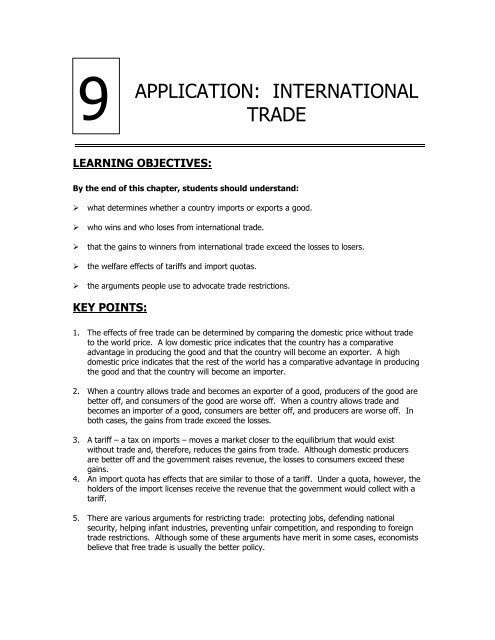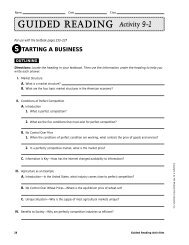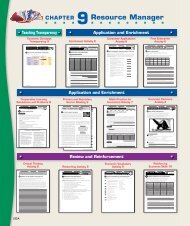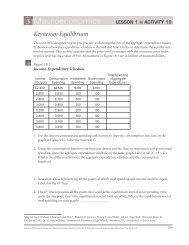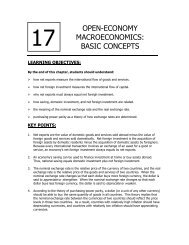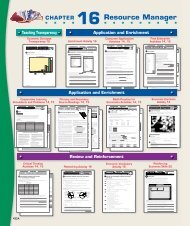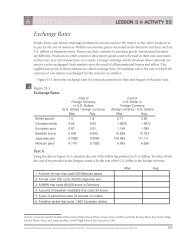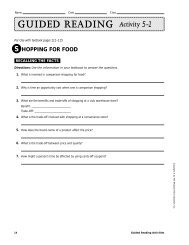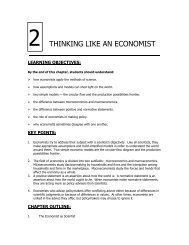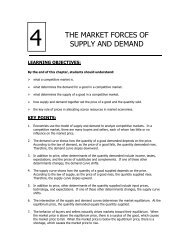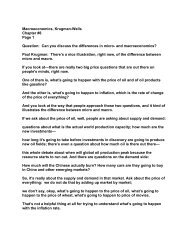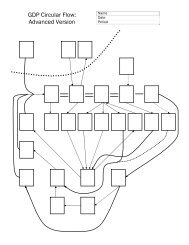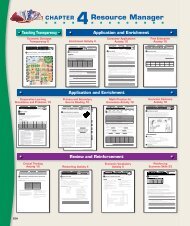You also want an ePaper? Increase the reach of your titles
YUMPU automatically turns print PDFs into web optimized ePapers that Google loves.
2. If the world price is greater than the domestic price, Isoland shouldexport steel; if the world price is lower than the domestic price, Isolandshould import steel.a. Note that the domestic price represents the opportunity cost ofproducing steel in Isoland, while the world price represents theopportunity cost of producing steel abroad.b. Thus, if the domestic price is low, this implies that theopportunity cost of producing steel in Isoland is low, suggestingthat Isoland has a comparative advantage in the production ofsteel. If the domestic price is high, the opposite is true.II.The Winners and Losers from TradeA. We can use welfare analysis to determine who will gain and who will lose if freetrade begins in Isoland.B. We will assume that, because Isoland would be such a small part of the marketfor steel, they will be price takers in the world economy. This implies that theytake the world price as given and must sell (or buy) at that price.C. The Gains and Losses of an Exporting Country1. If the world price is higher than the domestic price, Isoland will exportsteel. Once free trade begins, the domestic price will rise to the worldprice.2. As the price of steel rises, the domestic quantity of steel demanded willfall and the domestic quantity of steel supplied will rise. Thus, withtrade, the domestic quantity demanded will not be equal to the domesticquantity supplied.PriceExportsSupplyPrice after tradeWorld PricePrice before tradeDemandQuantitydemandedQuantitysuppliedQuantity
PriceExportsSupplyPrice after tradeABDWorld PricePrice before tradeCDemand3. Welfare Before TradeQuantitya. Consumer surplus is equal to: A + B.b. Producer surplus is equal to: C.c. Total surplus is equal to: A + B + C.4. Welfare After Tradea. Consumer surplus is equal to: A.b. Producer Surplus is equal to: B + C + D.c. Total surplus is equal to: A + B + C + D.5. Changes in Welfarea. Consumer surplus changes by: -B.b. Producer surplus changes by: +(B + D).c. Total surplus changes by: +D.6. When a country exports a good, domestic producers are better off anddomestic consumers are worse off.7. When a country exports a good, total surplus is increased and theeconomic well-being of the country rises.D. The Gains and Losses of an Importing Country
c. Total surplus is equal to : A + B + C.4. Welfare After Tradea. Consumer surplus is equal to: A + B + D.b. Producer surplus is equal to: C.c. Total surplus is equal to: A + B + C + D.5. Changes in Welfarea. Consumer surplus changes by: +(B + D).b. Producer surplus changes by: -B.c. Total surplus changes by: +D.6. When a country imports a good, domestic consumers are better off anddomestic producers are worse off.7. When a country imports a good, total surplus is increased and theeconomic well-being of the country rises.8. In the News: Life in IsolandE. The Effects of a Tariffa. In 1998, President Clinton threatened to limit cheap steelimports into the United States.b. This is an article from The New York Times discussing thePresident’s statement.1. Definition of Tariff: a tax on goods produced abroad and solddomestically.2. A tariff raises the price above the world price. Thus, the domestic priceof steel will rise to the world price plus the tariff.3. As the domestic price rises, the domestic quantity of steel demanded willfall and the domestic quantity of steel supplied will rise. The quantity ofimports will fall and the market will move closer to the domestic marketequilibrium which occurred before trade.4. Welfare Before the Tariff (with trade)a. Consumer surplus is equal to: A + B + C + D + E + F.b. Producer surplus is equal to: G.c. Total surplus is equal to : A + B + C + D + E + F + G.
PriceSupplyAPrice aftertradeCGDEBFWorld Price + tariffWorld PriceDemandQuantityImports after tariff5. Welfare After Tariff (with trade)a. Consumer surplus is equal to: A + B.b. Producer surplus is equal to: C + G.c. Tariff revenue is equal to: E.d. Total surplus is equal to: A + B + C + E + G.5. Changes in Welfarea. Consumer surplus changes by: -(C + D + E + F).b. Producer surplus changes by: +C.c. Tariff revenue changes by: +E.d. Total surplus changes by: -(D + F).E. The Effects of an Import Quota
1. Definition of Import Quota: a limit on the quantity of a good thatcan be produced abroad and sold domestically.PriceSupplySupply + quotaAPrice after quotaPrice after tradeCE'BE"World PriceGDFDemandQuantityImports with quota2. An import quota alters the supply of steel available. The supply is nolonger perfectly elastic at the world price, but is equal to the domesticsupply plus the quota amount.3. The domestic price will rise, the domestic quantity of steel demanded willfall and the domestic quantity of steel supplied will rise. The quantity ofimports will fall and the market will move closer to the domestic marketequilibrium which occurred before trade.4. Welfare Before Import Quota (with trade)a. Consumer surplus is equal to: A + B + C + D + E' + E" + F.b. Producer surplus is equal to: G.c. Total surplus is equal to : A + B + C + D + E' + E" + F + G.5. Welfare After Import Quota (with trade)a. Consumer surplus is equal to: A + B.b. Producer surplus is equal to: C + G.c. License-holder surplus is equal to: E' + E".d. Total surplus is equal to: A + B + C + E' + E" + G.5. Changes in Welfarea. Consumer surplus changes by: -(C + D + E' + E" + F).
. Producer surplus changes by: +C.c. License-holder surplus changes by: +(E' + E").d. Total surplus changes by: -(D + F).F. The Lessons for Trade Policy1. If trade is allowed, the price of steel will be driven to the world price. Ifthe domestic price is higher than the world price, the country will importand the domestic price will fall. If the domestic price is lower than theworld price, the country will export and the domestic price will rise.2. If a country imports a product, domestic producers are made worse off,domestic consumers are made better off, and the gains of consumersoutweigh the losses of producers. If a country exports a product,domestic producers are made better off, domestic consumers are madeworse off, and the gains of producers outweigh the losses of consumers.3. Both a tariff and an import quota would create a deadweight lossbecause total surplus would fall.G. FYI: Other Benefits of International Trade1. In addition to increasing total surplus, there are several other benefits offree trade.2. These include an increased variety of goods, lower costs througheconomies of scale, increased competition, and an enhanced flow ofideas.III.The Arguments for Restricting TradeA. The Jobs Argument1. If a country imports a product, domestic producers of the product willhave to lay off workers because they will decrease domestic output whenthe price decreases to the world price.2. Free trade, however, will create job opportunities in other industrieswhere the country enjoys a comparative advantage.B. The National-Security Argument1. Certain industries may produce key resources needed to produceproducts necessary for national security.2. Much of the time that this argument is used, however, the role of themarket in providing national security is exaggerated.C. The Infant-Industry Argument
1. New industries need time to get established to be able to compete inworld markets.2. Even if this argument is legitimate, it is nearly impossible for thegovernment to choose which industries will be profitable in the futureand it is even more difficult to remove tariffs or quotas in an industryonce they are in place.D. The Unfair-Competition Argument1. It is unfair if firms in one country are forced to comply with moreregulations than firms in another country, or another governmentsubsidizes the production of a good.2. Even if another country is subsidizing the production of a product so thatit can be exported to a country at a lower price, the domestic consumerswho import the product gain more than the domestic producers lose.E. The Protection-As-A-Bargaining-Chip Argument1. Threats of protectionism can make other countries more willing toreduce the amounts of protectionism they use.2. If the threat does not work, the country has to decide if it would ratherreduce the economic well-being of its citizens (by carrying out thethreat) or lose credibility in negotiations (by reneging on its threat).F. In the News: A Chicken Invasion1. In a move to protect the Russian poultry industry, the Russiangovernment threatened to ban the sale of U.S. poultry because “it poseda health risk.” The U.S. government argued that this action wasinconsistent with Russia’s desire to become a part of the World TradeOrganization.2. Interestingly, the Russian consumers still prefer American poultry overRussian poultry because it is believed to have a higher level of quality(even after the Russian government health warnings were announced).3. This is an article from The New York Times discussing this situation.G. Case Study: Trade Agreements1. Countries wanting to achieve freer trade can take two approaches tocutting trade restrictions: a unilateral approach or a multilateralapproach.2. A unilateral approach occurs when a country lowers its trade restrictionson its own. A multilateral approach occurs when a country reduces itstrade restrictions while other countries do the same.
3. The North America Free Trade Agreement (NAFTA) and the GeneralAgreement on Tariffs and Trade (GATT) are multilateral approaches toreducing trade barriers.H. In the News: The Case for Unilateral Disarmament in the Trade Wars1. The United States can lead in the fight for freer trade by cutting its owntrade restrictions unilaterally.2. This is an article written by economist Jagdish Bhagwati for The WallStreet Journal arguing this point.


